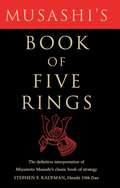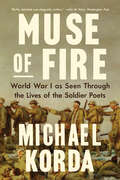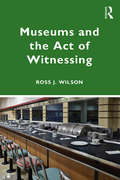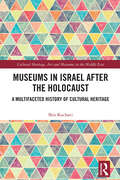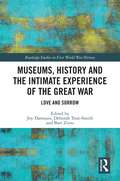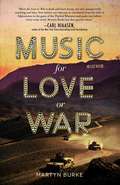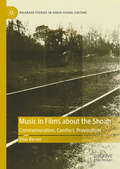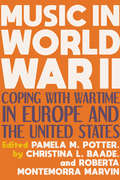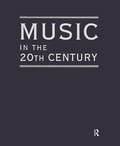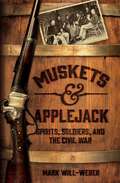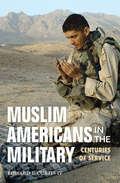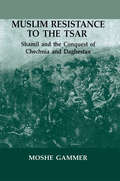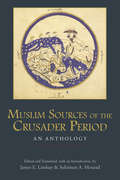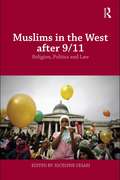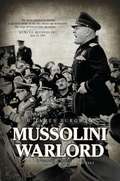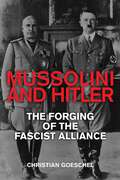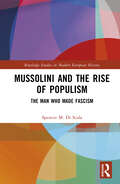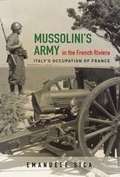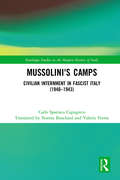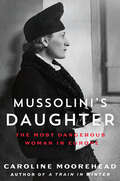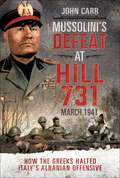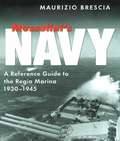- Table View
- List View
Murphy's Law: My Journey from Army Ranger and Green Beret to Investigative Journalist
by Jack MurphyFor fans of the New York Times bestsellers The Last Punisher and Lone Survivor, a heart-pounding military memoir from a former Army Ranger sniper and Special Operations weapon sergeant-turned-journalist about the incredible highs and devastating lows of his career. Growing up in small New York towns, Jack Murphy knew he wanted to lead a life far from the ordinary—a life of adventure and valor. After the 9/11 attacks, he immediately enlisted in the Army, knowing this was his chance to live the life he desired and fight for a cause he staunchly supported. After making it through the rigorous Ranger Indoctrination Program, he graduated sniper school and was promptly deployed to Afghanistan, where his experiences went from ordinary to extraordinary. In this gripping military memoir, Murphy recounts the multiple missions he underwent as a Ranger, a Special Forces weapons sergeant, and ultimately, a boots-on-the-ground journalist. From enemy ambushes, dodging explosives, crashing terrorists’ weddings, and landing helicopters in the streets of Mosul, Jack provides a hard-hitting glimpse of what combat is like in some of the world’s most dangerous, war-torn places. With tours of duty in two of the most decorated units of the armed forces, Murphy brings a unique perspective to the military genre as he reflects on his great triumphs and shattering failures both on and off the battlefield. Later, Murphy turned his attention to breaking news within the military. His stories have taken him from Iraq to Switzerland, from Syria to South Korea. From crossing Middle Eastern borders in the dead of night, to rolling into an IED-laden zone, Murphy’s stories are always a thrill a minute. Murphy’s Law tells a story of intense bravery and sacrifice—both on and off the battlefield.
Musashi's Book of Five Rings
by Stephen F. KaufmanOften used to explain Japanese business competition, Musashi's Book of Five Rings is more properly a definitive treatise on mortal combat from one of Japan's most formidable warriors - the martial arts luminary Miyamoto Musashi. Famed martial artist Stephen Kaufman has translated this classic without the usual commercial bias, driving straight to the heart of Musashi's incisive martial arts stratagems. The result is an enthralling combination of powerful technical wisdom and the philosophical elucidation offered to martial artists by Buddhism, Shintoism, Confucianism, and Taoism. From the metaphor of the Four Elements and fundamentals of physical practice and strategy to an offering of Zen wisdom on the "way" of nature, Musashi's Book of Five Rings is as profound and important a book on martial arts as you will find.
Musashi's Book of Five Rings
by Stephen F. KaufmanMiyamoto Musashi is the greatest martial artist and warrior Japan has ever known. His Book of Five Rings is the definitive Japanese treatise on warfare, mortal combat and the chivalrous code of the samurai known simply as Bushido--the "Way of the Warrior." This classic book by Stephen Kaufman is a modern interpretation of Musashi's work specifically intended for today's martial artist. It explains the essential truths found in the Book of Five Rings that are necessary for a full understanding of Musashi's message as it was originally intended--as a practical training manual for warriors. The result is an enthralling treatise on martial strategy combining a warrior's instincts with the deep philosophical insights of Buddhism, Shintoism, Confucianism and Taoism. It is a book that every modern warrior should read and absorb.
Musashi's Book of Five Rings
by Stephen F. KaufmanThis classic work interprets Miyamoto Musashi's famous Book of Five Rings specifically for the martial artist-as Miyamoto Musashi originally intended. It explains the underlying truths necessary for a full understanding of Musashi's message for warriors. The result is an enthralling book on martial strategy that combines the instincts of the warrior with the philosophies of Zen Buddhism, Shintoism, Confucianism and Taoism. It is a crucial book for every martial artist to read and understand. Like the original, this book is divided into five sections. The Book of Earth lays the groundwork for anyone wishing to understand Musashi's teachings; the Book of Water explains the warrior's approach to strategy; the Book of Fire teaches fundamental fighting techniques based on the Earth and Water principles; the Book of Wind describes differences between Musashi's own martial style and the styles of other fighting schools; while the Book of No-thing describes the "way of nature" as understood through an "unthinking" existing preconception.Famed martial artist Stephen Kaufman has translated this classic without the usual academic or commercial bias, driving straight into the heart of Musashi's martial teachings and interpreting them for his fellow martial artists.
Muse of Fire: World War I as Seen Through the Lives of the Soldier Poets
by Michael KordaThe First World War comes to harrowing life through the intertwined lives of the soldier poets in Michael Korda’s epic Muse of Fire. Michael Korda, the best-selling author of Hero and Alone, tells the story of the First World War not in any conventional way but through the intertwined lives of the soldier poets who came to describe it best, and indeed to symbolize the war’s tragic arc and lethal fury. His epic narrative begins with Rupert Brooke, “the handsomest young man in England” and perhaps its most famous young poet in the halcyon days of the Edwardian Age, and ends five years later with Wilfred Owen, killed in action at twenty-five, only one week before the armistice. With bitter irony, Owen’s mother received the telegram informing her of his death on November 11, just as church bells tolled to celebrate the war’s end. Korda’s dramatic account, which includes anecdotes from his own family history, not only brings to life the soldier poets but paints an unforgettable picture of life and death in the trenches, and the sacrifice of an entire generation. His cast of characters includes the young American poet Alan Seeger, who was killed in action as a private in the French Foreign Legion; Isaac Rosenberg, whose parents had fled czarist anti-Semitic persecution and who was killed in action at the age of twenty-eight before his fame as a poet and a painter was recognized; Robert Graves and Siegfried Sassoon, whose friendship and friendly rivalry endured through long, complicated private lives; and, finally, Owen, whose fame came only posthumously and whose poetry remains some of the most savage and heartbreaking to emerge from the cataclysmic war. As Korda demonstrates, the poets of the First World War were soldiers, heroes, martyrs, victims, their lives and loves endlessly fascinating—that of Rupert Brooke alone reads like a novel, with his journey to Polynesia in pursuit of a life like Gauguin’s and some of his finest poetry written only a year before his tragic death. Muse of Fire is at once a portrait of their lives and a narrative of a civilization destroying itself, among the rubble, shadows, and the unresolved problems of which we still live, from the revival of brutal trench warfare in Ukraine and in the Middle East.
Museums and the Act of Witnessing
by Ross J. WilsonMuseums and the Act of Witnessing examines how representations of traumatic histories and the legacies of the twentieth century in museums and heritage sites across the world shape political, social and cultural identities. Drawing on an interdisciplinary analysis of a variety of museum exhibitions around the globe, the book demonstrates how the narrative of ‘witnessing’ has shaped representation of war, genocide, repression and violence. Revealing that this form of presentation is inherently Western in its origins and nature, Wilson goes on to argue that witnessing the past is to colonise the future, as we project a certain view of the events of the past onto the present. Detailing the character, content and meanings of representation that focus on the traumatic events of the twentieth century, the book demonstrates the way in which visitors are cast as ‘witnesses’ and questions what the true purpose of witnessing really is. Museums and the Act of Witnessing draws attention to the fact that we have inherited a distinct, and often limited, mode of seeing the past and considers how we can more effectively engage with the past in the present. The book will be of interest to academics and students engaged in the study of museums, history, sociology, conflict, politics and memory.
Museums in Israel after the Holocaust: A Multifaceted History of Cultural Heritage (Cultural Heritage, Art and Museums in the Middle East)
by Shir Gal KochaviMuseums in Israel After the Holocaust explores the influence of the traumatic events of the Holocaust on the formation of a cultural heritage policy during the foundational years of the State of Israel.Based on primary research, the book offers a new understanding of cultural practices after the Second World War, while analyzing the role of key Jewish cultural representatives who shaped museum collections that emerged during this period. The book investigates the ways Israel has dealt with the complicated history of “heirless” Jewish cultural objects and questions of ownership, by providing a detailed examination of the process of allocation of “heirless” Jewish cultural property handled by two American-Jewish organizations: the Jewish Restitution Successor Organization (JRSO) and the Jewish Cultural Reconstruction (JCR) in the immediate years following the Second World War. The book takes a material culture approach, which explores the meanings and values attached to an object over the course of time and during its transition between different owners.Museums in Israel After the Holocaust is essential reading for academics, students, and professionals working on and interested in Holocaust and Israel studies, art history, material culture studies, museum studies, cultural heritage, and Middle Eastern studies.
Museums, History and the Intimate Experience of the Great War: Love and Sorrow (Routledge Studies in First World War History)
by Joy Damousi Bart Ziino Deborah Tout-SmithThe Great War of 1914-1918 was fought on the battlefield, on the sea and in the air, and in the heart. Museums Victoria’s exhibition World War I: Love and Sorrow exposed not just the nature of that war, but its depth and duration in personal and familial lives. Hailed by eminent scholar Jay Winter as "one of the best which the centenary of the Great War has occasioned", the exhibition delved into the war’s continuing emotional claims on descendants and on those who encounter the war through museums today. Contributors to this volume, drawn largely from the exhibition’s curators and advisory panel, grapple with the complexities of recovering and presenting difficult histories of the war. In eleven essays the book presents a new, more sensitive and nuanced narrative of the Great War, in which families and individuals take centre stage. Together they uncover private reckonings with the costs of that experience, not only in the years immediately after the war, but in the century since.
Music for Love or War
by Martyn Burke"Music for Love or War is slash-and-burn funny, but also unexpectedly touching and wise. Few writers can take you in one breath from the hills of Afghanistan to the gates of the Playboy Mansion and make you believe every crazy word. Martyn Burke has that special talent." --Carl Hiaasen, author of the New York Times bestselling novel Bad MonkeyAccording to what we've been told, the source of all knowledge is somewhere just south of Sunset Boulevard. The problem is that Danny has lost the address. So begins Martyn Burke's tragi-comic novel of love and war. Danny, a Canadian sharpshooter, and Hank, in the U.S. Army, have been stationed in Kandahar, but they are in Los Angeles, desperate to find the Hollywood psychic who will reveal the whereabouts of the women they love. Danny is searching for Ariana, the girl he fell in love with in Toronto in the last years of the twentieth century; Hank is searching for Annie Boudreau, known in the tabloids as "Annie of the Boo Two"--twins who were briefly in the gravitational pull of Hugh Hefner. From Grenadier Pond in west-end Toronto, to Afghanistan, to the Malibu colony in LA, the novel follows these moments in the lives of Danny and Hank, revealed by a masterful storyteller and commentator on American culture. When in the mountains of Kandahar, Danny and Hank torture the members of al Qaeda and the Taliban with the music and a larger-than-life-size cardboard reproduction of Liberace in satin short shorts, high-kicking as if on Broadway.
Music in Films about the Shoah: Commemoration, Comfort, Provocation (Palgrave Studies in Audio-Visual Culture)
by Elias BernerThis book focuses on the aural and musical sphere of fictional audio-visual reconstructions of the Holocaust, a defining event in the history of the 20th century. Musicology has seen an increasing number of works on the function of film music and the construction of identity in media contexts in recent years. This project analyses the use of music in feature films about the Shoah. The analysis of 'the sound of Nazi violence', as well as the escape from and resistance against it, not only reveals a lot about the construction of the filmic characters' emotive states, but also tells us more about our own relationship to the past. The author understands the soundtrack of these films as an affective mediator of time, which connects filmic representations of the past with the present. Analysis focuses on the soundtracks of four films: Schindler's List, The Pianist, Taking Sides and Inglourious Basterds.
Music in World War II: Coping with Wartime in Europe and the United States
by Pamela M. Potter, Christina L. Baade, and Roberta Montemorra MarvinA collection of essays examining the roles played by music in American and European society during the Second World War.Global conflicts of the twentieth century fundamentally transformed not only national boundaries, power relations, and global economies, but also the arts and culture of every nation involved. An important, unacknowledged aspect of these conflicts is that they have unique musical soundtracks. Music in World War II explores how music and sound took on radically different dimensions in the United States and Europe before, during, and after World War II. Additionally, the collection examines the impact of radio and film as the disseminators of the war’s musical soundtrack. Contributors contend that the European and American soundtrack of World War II was largely one of escapism rather than the lofty, solemn, heroic, and celebratory mode of “war music” in the past. Furthermore, they explore the variety of experiences of populations forced from their homes and interned in civilian and POW camps in Europe and the United States, examining how music in these environments played a crucial role in maintaining ties to an idealized “home” and constructing politicized notions of national and ethnic identity. This fascinating, well-constructed volume of essays builds understanding of the role and importance of music during periods of conflict and highlights the unique aspects of music during World War II.“A collection that offers deeply informed, interdisciplinary, and original views on a myriad of musical practices in Europe, Great Britain, and the United States during the period.” —Gayle Magee, co-editor of Over Here, Over There: Transatlantic Conversations on the Music of World War I
Music in the 20th Century (3 Vol Set)
by Dave DiMartinoThis is an examination of the crucial formative period of Chinese attitudes toward nuclear weapons, the immediate post-Hiroshima/Nagasaki period and the Korean War. It also provides an account of US actions and attitudes during this period and China's response.
Muskets and Applejack: Spirits, Soldiers, and the Civil War
by Mark Will-Weber"I wish some of you would tell me the brand of whiskey that Grant drinks. I would like to send a barrel of it to my other generals."- President Abraham Lincoln, when confronted about General Ulysses Grant's excessive drinking.Blood, gunfire, and whiskey: they are the three things that defined Civil War battlefields. In this fascinating, booze-drenched history of the war that almost tore America apart, historian Mark Will-Weber (author of Mint Juleps with Teddy Roosevelt) weaves together lighthearted stories of drunken generals and out-of-control soldiers with the gritty reality of battlefields where whiskey was the only medicine-and sometimes the only food.Muskets and Applejack paints a full, complex picture of the surprisingly large role alcohol played in the Civil War: how it helped heal physical and emotional wounds, form friendships, and cause strife. Interspersed between stories from the battlefield are authentic recipes of soldiers' favorite drinks-from both sides of the Mason-Dixon line.
Muslim Americans in the Military: Centuries of Service (Encounters: Explorations in Folklore and Ethnomusicology)
by Edward E. Curtis IVStories of Muslims who have served, dating back to the Revolutionary War. Since the Revolutionary War, Muslim Americans have served in the United States military, risking their lives to defend a country that increasingly looks at them with suspicion and fear. In Muslim Americans in the Military: Centuries of Service, Edward E. Curtis illuminates the long history of Muslim service members who have defended their country and struggled to practice their faith. With profiles of soldiers, marines, airmen, and sailors since the dawn of our country, Curtis showcases the real stories of Muslim Americans, from Omer Otmen, who fought fiercely against German forces during World War I, to Captain Humayun Khan, who gave his life in Iraq in 2004. These true stories contradict the narratives of hate and fear that have dominated recent headlines, revealing the contributions and sacrifices that these soldiers have made to the United States.
Muslim Resistance to the Tsar: Shamil and the Conquest of Chechnia and Daghestan
by Moshe GammerFirst published in 2003. Routledge is an imprint of Taylor & Francis, an informa company.
Muslim Sources of the Crusader Period: An Anthology
by James E. Lindsay Suleiman Ali MouradDrawn from greater Syria, northern Mesopotamia, and Egypt, the sources in this anthology—many of which are translated into English for the first time here--provide eyewitness and contemporary historical accounts of what unfolded in the eastern Mediterranean and the Near East between the eleventh and fourteenth centuries. In providing representative examples of the many disparate types of Muslim sources, this volume opens a window onto life in the Islamic Near East during the Crusader period and the interactions between Franks and Muslims in the broader context of Islamic history. Ideally suited for use in undergraduate courses on the Crusades or the pre-modern Islamic Near East, this anthology will also appeal to any readers seeking a better understanding of the Islamic response to the Crusades and the general history of the Near East in this period.
Muslims in the West after 9/11: Religion, Politics and Law (Routledge Studies in Liberty and Security)
by Jocelyne CesariThis book is the first systematic attempt to study the situation of European and American Muslims after 9/11, and to present a comprehensive analysis of their religious, political, and legal situations. Since 9/11, and particularly since the Madrid and London bombings of 2004 and 2005, the Muslim presence in Europe and the United States has become a major political concern. Many have raised questions regarding potential links between Western Muslims, radical Islam, and terrorism. Whatever the justification of such concerns, it is insufficient to address the subject of Muslims in the West from an exclusively counter-terrorist perspective. Based on empirical studies of Muslims in the US and Western Europe, this edited volume posits the situation of Muslim minorities in a broader reflection on the status of liberalism in Western foreign policies. It also explores the changes in immigration policies, multiculturalism and secularism that have been shaped by the new international context of the ‘war on terror’. This book will be of great interest to students of Critical Security Studies, Islamic Studies, Sociology and Political Science in general. Jocelyne Cesari is an Associate at Harvard’s Center for Middle Eastern Studies and the Center for European Studies, teaching at Harvard Divinity School and the Government Department, specializing in Islam and the Middle East.
Mussolini Warlord
by H. James BurgwynFascist Italy has received far too little attention in the military history of the Axis partnership. This is the first comprehensive study of Benito Mussolini's military efforts to build an empire during World War II. It details the fascist dictator's attempt to build both a Mediterranean empire and Balkan empire, as well as a narrative history of his tragically flawed illusions; Italy's disastrous military performance; the heroism of Italian soldiers, sailors, and airmen; and the brutal counterinsurgency programs. Italy's various war theaters are discussed singly, with major battles outlined, military aptitude and results judged, and relations with the Axis partner described. Fascist ideology and the Italian army's conduct in the occupied territories--France, Yugoslavia, Albania, Greece, Russia, East Africa, and North Africa--are also analyzed. Mussolini was the single individual most responsible for Italy's failure during World War II. H. James Burgwyn is professor emeritus of history at Westchester University and the author of important works on modern Italian history.
Mussolini and Hitler: The Forging of the Fascist Alliance
by Christian GoeschelThis fresh treatment of Fascist Italy and Nazi Germany reveals how the close relationship between Mussolini and Hitler influenced both men.From 1934 until 1944 Mussolini met Hitler numerous times, and the two developed a relationship that deeply affected both countries. While Germany is generally regarded as the senior power, Christian Goeschel demonstrates just how much history has underrepresented Mussolini’s influence on his German ally.A scholar of twentieth-century Germany and Italy, Goeschel revisits all of Mussolini and Hitler’s key meetings to examine how they constructed a powerful image of a strong Fascist-Nazi relationship that still resonates with the general public. His portrait of Mussolini draws on sources ranging beyond political history to reveal a leader who, at times, shaped Hitler’s decisions and was not the gullible buffoon he’s often portrayed as. The first comprehensive study of the Mussolini-Hitler relationship, this book is a must-read for scholars and anyone interested in the history of European fascism, World War II, or political leadership.
Mussolini and the Rise of Populism: The Man who Made Fascism (Routledge Studies in Modern European History)
by Spencer DiScalaThis book analyzes the process by which Mussolini built the world’s first Fascist regime, describes how the Duce’s heirs have adapted to current political conditions, and how they have gone mainstream. With the rise of populism of the right in the new millennium, Benito Mussolini’s name has returned forcefully to the limelight. Populist movements closely resemble historical fascism, and former President Donald J. Trump has been compared to the Duce. In 2022, the 100th anniversary of the Duce’s taking power, an Italian populist party inspired by fascism took control of the country’s government led by its first woman Prime Minister. By finding in fascism their inspiration to confront the current epoch’s deep transformations, they have taken command in a major European liberal democratic country for the first time since 1945. How this occurred demonstrates the modernity and appeal of Mussolini’s fascism and offers new perspectives in interpreting populism. While the worst elements of fascism have not yet appeared in populist movements, this book conveys in clear language, a more precise awareness of the forces and values that propelled fascism to power and that drive the march of rightist populism worldwide. This volume is essential reading for students, scholars, general observers and commentators interested in European and modern history.
Mussolini's Army in the French Riviera: Italy's Occupation of France
by Emanuele SicaIn contrast to its brutal seizure of the Balkans, the Italian Army's 1940-1943 relatively mild occupation of the French Riviera and nearby alpine regions bred the myth of the Italian brava gente , or good fellow, an agreeable occupier who abstained from the savage wartime behaviors so common across Europe. Employing a multi-tiered approach, Emanuele Sica examines the simultaneously conflicting and symbiotic relationship between the French population and Italian soldiers. At the grassroots level, Sica asserts that the cultural proximity between the soldiers and the local population, one-quarter of which was Italian, smoothed the sharp angles of miscommunication and cultural faux-pas at a time of great uncertainty. At the same time, it encouraged a laxness in discipline that manifested as fraternization and black marketeering. Sica's examination of political tensions highlights how French prefects and mayors fought to keep the tatters of sovereignty in the face of military occupation. In addition, he reveals the tense relationship between Fascist civilian authorities eager to fulfil imperial dreams of annexation and army leaders desperate to prevent any action that might provoke French insurrection. Finally, he completes the tableau with detailed accounts of how food shortages and French Resistance attacks brought sterner Italian methods, why the Fascists' attempted "Italianization" of the French border city of Menton failed, and the ways the occupation zone became an unlikely haven for Jews.
Mussolini's Camps: Civilian Internment in Fascist Italy (1940-1943) (Routledge Studies in the Modern History of Italy)
by Carlo Spartaco CapogrecoThis book—which is based on vast archival research and on a variety of primary sources—has filled a gap in Italy’s historiography on Fascism, and in European and world history about concentration camps in our contemporary world. It provides, for the first time, a survey of the different types of internment practiced by Fascist Italy during the war and a historical map of its concentration camps. Published in Italian (I campi del duce, Turin: Einaudi, 2004), in Croatian (Mussolinijevi Logori, Zagreb: Golden Marketing – Tehnička knjiga, 2007), in Slovenian (Fašistična taborišča, Ljublana: Publicistično društvo ZAK, 2011), and now in English, Mussolini’s Camps is both an excellent product of academic research and a narrative easily accessible to readers who are not professional historians. It undermines the myth that concentration camps were established in Italy only after the creation of the Republic of Salò and the Nazi occupation of Italy’s northern regions in 1943, and questions the persistent and traditional image of Italians as brava gente (good people), showing how Fascism made extensive use of the camps (even in the occupied territories) as an instrument of coercion and political control.
Mussolini's Daughter: The Most Dangerous Woman in Europe
by Caroline MooreheadThe bestselling author of A Train in Winter returns with the definitive story of Mussolini&’s daughter, Edda, one of the most influential women in 1930s Italy, whose life had more twists and turns than a spy novel.Edda Mussolini was Benito's favourite child: spoiled and venal, uneducated but clever, faithless but flamboyant, a brilliant diplomat, wild but brave, and ultimately strong and loyal. For much of the twenty-year period of Fascist rule, she was her father's closest confidante.In 1930, at the age of nineteen, Edda married Count Galeazzo Ciano, who would become the youngest Foreign Secretary in Italian history. Acting as envoy to both Germany and Britain, Edda played a part in steering Italy to join forces with Hitler. During this time, the Cianos became the most celebrated and glamorous couple in elegant, vulgar Roman fascist society.Their fortunes turned in 1943, when Ciano voted against Mussolini in a plot to bring him down, and his father-in-law did not forgive him. Edda's dramatic story includes hidden diaries, her father's downfall and her husband's execution, and an escape into Switzerland followed by a period in exile. Moorehead draws a portrait of a complicated, bold, and determined woman—one who emerges not just as a witness but as a key player in some of the twentieth century's defining moments. And we see Fascist Italy with all its glamour, decadence and political intrigue, and the turbulence before its violent end.
Mussolini's Defeat at Hill 731, March 1941: How the Greeks Halted Italy's Albanian Offensive
by John CarrThis WWII history examines the most consequential and hard-fought battle between Greek and Italian forces in Albania.On March 9th, 1941, the Italians launched their Spring Offensive, designed to stem four months of humiliating reverses. Watched by Mussolini himself, the operation’s objective was a pair of parallel valleys dominated by the Greek-held Hill 731. The Italian Eighth Corps, part of Geloso’s 11th Army, had the task of seizing the heights, spearheaded by 38 (Puglie) Division. Holding the position was the Greek 1 Division of II Corps, with 4 and 6 Division on the flanks.For seventeen days, after a massive artillery barrage, the Italians threw themselves against the Evzones on the hill—only to be repeatedly smashed with appalling losses. It was a merciless fight at close quarters, where bayonets held the place of honor but the battered Greeks held. Mussolini had wanted a spring victory to impress the Führer. Instead, the bloody debacle of Hill 731 could well have contributed to Hitler’s decision to postpone his invasion of Russia. John Carr sheds light on this consequential episode in the Mediterranean theater of operations.
Mussolini's Navy: A Reference Guide to the Regia Marina, 1930–1945
by Maurizio Brescia&“A simply magnificent book describing the Italian Navy of the Second World War, profiling all classes of vessels, from battleships . . . [to] submarines.&” —Pegasus Archive This book is a complete guide to the Regia Marina, the navy with which Italy fought the Second World War. Starting with the historical background, it describes how the navy developed, how it was organized, the facilities that supported it, and the operations it conducted both before and after the armistice in 1943. It also details all its ships, with full technical particulars, plans and photos. Furthermore, there are chapters on special topics like camouflage; uniforms, decorations and insignia; and a &“who&’s who&” of important naval personalities; and the reference value of the book is enhanced by a comprehensive bibliography and guide to sources. The illustration is a noteworthy feature of the book as the author&’s collection of naval photographs is one of the best in Italy. He is also a fine draughtsman, and his ship plans and color illustrations are both detailed and accurate, adding a particular appeal for modelmakers. Of all the main combatant navies of this era, the Italian is probably the most poorly represented in English publications, so this comprehensive handbook will be especially welcomed by the naval community.&“An overview of the wartime Italian Navy, including its bases and organization, ships and aircraft . . . an enjoyable book.&” —Warships International Fleet Review&“A major achievement and a milestone in the renaissance of Italian Naval history . . . [the] book is a gem and is thoroughly recommended.&” —The Navy Vol 75

